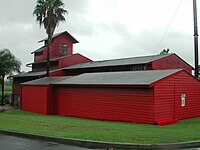
Photo from wikipedia
In tea brick fermentation, the temperature in the fermentation chamber has an important influence on the reproduction and growth of the golden flower bacteria inside tea bricks. In order to… Click to show full abstract
In tea brick fermentation, the temperature in the fermentation chamber has an important influence on the reproduction and growth of the golden flower bacteria inside tea bricks. In order to form a uniform and suitable fermentation temperature, the study introduced an upward vertical wall attached ventilation based on the load distribution characteristics of the tea brick fermentation chamber and the practical placement of tea bricks on the shelf. The air distribution of upward vertical wall attached ventilation under different supply air temperature differences was numerically investigated by a mathematical model of flow and heat transfer. Furthermore, the results were compared with two other traditional ventilation modes, which are diffuser ventilation and displacement ventilation. The upward vertical wall attached ventilation demonstrated higher ventilation efficiency and least vertical temperature stratification due to its lower flow resistance. Thus, the temperature unevenness coefficient in the product area could be reduced by between 54.3% and 77.5% compared with the diffuser dilute ventilation and displacement ventilation. Moreover, the upward vertical wall attached ventilation could help to eliminate the indoor heat load during the fermentation of tea bricks, which increases the energy utilisation rate of supply air by 1.7%–18.5%. Therefore, the vertical wall attached ventilation can effectively improve the temperature distribution of the tea brick fermentation chamber and improve the energy utilisation of the air supply.
Journal Title: Biosystems Engineering
Year Published: 2020
Link to full text (if available)
Share on Social Media: Sign Up to like & get
recommendations!